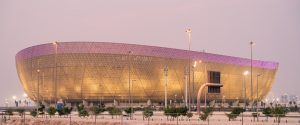Thanks to good relations with Qatar, China has been entrusted with making a major contribution to the 2022 FIFA World Cup. Several elements of the sporting event, which opened with much fanfare on November 20, have been developed by Chinese firms, ranging from stadiums and souvenirs to renewable energy vehicles.
Perhaps China’s most significant contribution was its role in the development of the Lusail Stadium, the main stadium for this year’s World Cup. In 2016, China Railway Construction Corporation won a $764 million contract to build the stadium, which will host the opening ceremony and 10 games, including the final, in a joint venture with Qatar’s HBK.
Lusail Stadium was built in the seaside city of Lusail in the north of Doha. The stadium was built with a membrane covering an area of 45,000 square meters, and has a capacity of 92,000. It is reported to be the largest membrane structure in the world. The Lusail Stadium was officially handed over in December 2020 and has since been featured on the newly issued Qatari 10 riyal note – an encouraging sign for the Chinese government.
China has also had a hand in the construction of other World Cup stadiums in Qatar. For example, at the Education City Stadium, the steel structure was made by a Chinese company. The same goes for Stadium 974, which is made from 974 recycled shipping containers, some of which were reportedly sourced from China.
Apart from the stadiums, China has also had a hand in constructing the renewable energy infrastructure for the tournament, particularly the Al Kharsaah Solar Power Plant. This plant was built by Chinese companies in a desert area about 80 kilometers west of Doha, and is capable of generating 800 megawatts of power, providing one of Qatar’s main sources of energy for the World Cup.
China is also involved in the construction of container houses designed to house visiting football fans. Since Qatar has only about 11,000 square kilometers of land, the Qatari government has been forced to build some 6,000 container houses to accommodate those attending the tournament. This housing area, known as the ‘Fans’ Village’ provides accommodation for around 12,000 people. Fans are also provided with bus shuttle services to and from World Cup venues. These buses, which include 1,500 buses and 888 electric buses, have also been made in China.
Chinese companies are among the greatest sponsors of the tournament. According to the London-based information services company GlobalData, Chinese companies’ sponsorship revenue sits at $1.4 billion, outpacing the $1.1 billion from U.S. companies.
Unsurprisingly, perhaps, China is also the source of many of the souvenirs that FIFA has produced for the World Cup. These include flags, soccer shoes, and table soccer machines, as well as the replicas of the tournament’s official trophy, which are being produced by the Dongguan Wagon Giftware company in Guangdong province. Souvenirs featuring La’eeb, the official mascot of the 2022 World Cup, have also been produced in Dongguan.
At least four factors explain China’s close involvement in the 2022 World Cup. The first and most obvious is the robust relations that have developed between China and Qatar in various sectors. Since the establishment of diplomatic relations in 1988, the two countries have developed strong bilateral relations. China is currently one of Qatar’s largest trading partners and Qatar is one of the main sources of China’s energy imports. Bilateral trade continues to grow strongly. In 2021, it reached a high point of $17 billion, up 57 percent compared to the previous year. Over the past 10 years, China has also steadily increased its investment in Qatar, taking significant stakes in key infrastructure and energy projects.
The second reason is even though China did not qualify for the World Cup, many Chinese fans have traveled to Qatar for the event – between 5,000 and 7,000 tickets have been bought by Chinese citizens – and China boasts one of the world’s largest World Cup television audiences. This has offered the Chinese government an opportunity to demonstrate to its people that their country can make a major contribution to a prestigious world event.
The third reason is that China’s involvement in the World Cup offers an opportunity for the marketing of its domestic companies. For China, sponsorship is a way of introducing its brands to the global market, and it is a matter of pride that Chinese products are displayed side by side with more established global brands.
The fourth reason concerns China’s longer-term ambitions. In 2011, a year before becoming president, Xi Jinping announced China’s ambition of qualifying for the World Cup, hosting the World Cup, and, in time, lifting the trophy itself. To that end, China has laid out plans to develop 70,000 soccer fields and 20,000 training centers, and the construction of at least 12 football stadiums by 2030.
In this sense, the Chinese government’s involvement in the preparations for the 2022 Qatar World Cup is a bridge to a longer-term achievement: namely to one day host the tournament itself.

































